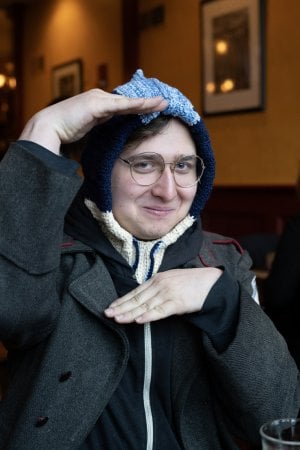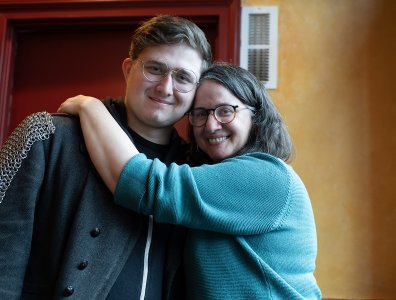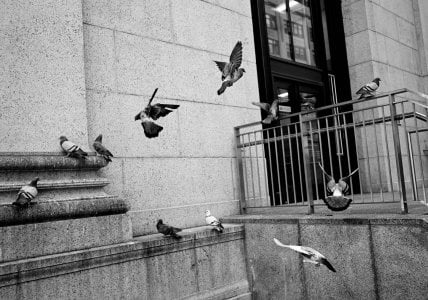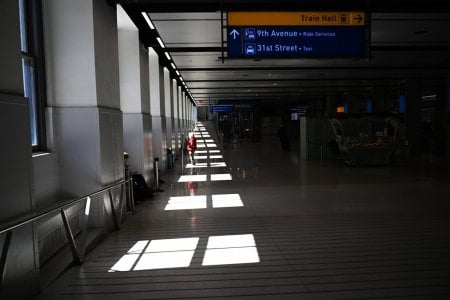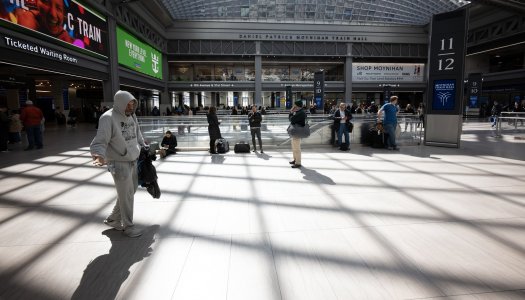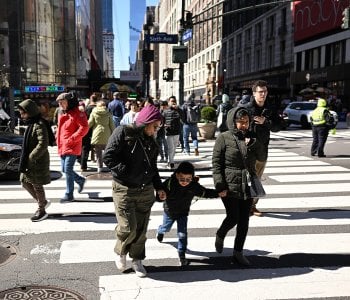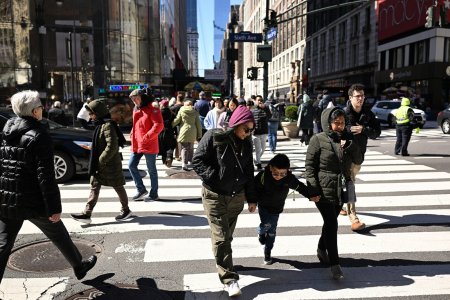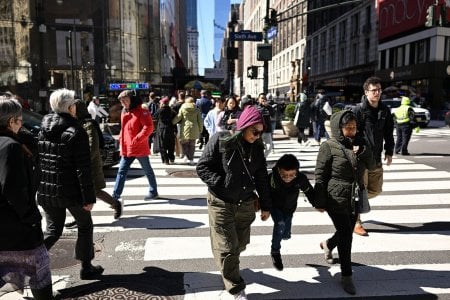Benjamin Marks
Mentor
Finally, even though I started this thread about adapted lenses, I did spend some time trying out the 35/1.8 that is native to the Z8 system. I am afraid that the lens doesn't show to its full potential here, and truthfully, I deleted most of the images I made with it in the context below. This is because of one of the Z8's maddening shortcomings. The camera is an immensely powerful imaging system. It can be customized for bird photography, for crying out loud. But with great power comes. . . . great complexity(?). The camera, for instance, has an eye-lock mode for taking portraits. Basically, you tell the camera through your menu selections that you want it to focus on the human eye, and it holds focus like a dog with a bone no matter how you or your subject move, shimmy, or sway. In theory, at least. In reality you have to watch painfully inefficient Youtube vidoes of camera "influencers" to figure out HOW to set these parameters and which menu settings are the right ones. And there are so many menus, with so many names that seem like they might be the subject matter that will give you this secret missle-lock type of focus that you can. . . miss them entirely. Ironically, I was much more successful with my 'dumb" Leica glass, zone focusing to a particular point on the street and then waiting for something to happen, than I was with my first stab at "missile lock." Why is this ironic? Well it is exactly the same technique that I would have used with my M9 (or M6) for that matter, if I was out for a day of urban observation. I did ultimately figure out the needed settings. Actually, "figured out" is overstating it. I finally >ahem< watched enough Youtube self-promotion to copy what the big dogs do and AFTER the day's street photography was over had the camera set up the way I think I will prefer. Honestly, 99% of the work I keep is portraiture of one kind or another, so this could be real game changer. More on this later.

As you can tell: overcast, drizzly, wet streets/sidewalks. Not a bad set up in terms of the photographic possibilities.
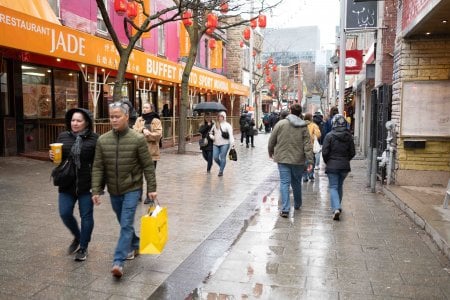
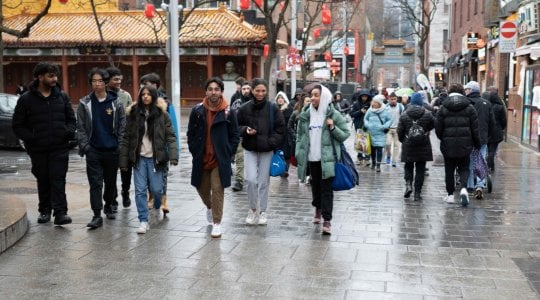
In the woulda-shoulda-coulda category, I think my "hit" rate will be much higher now that I have the menu settings figured out somewhat. I have been thinking of printing them out on a laminated card to put in my camera bag in the event that I have to do a factory re-set at some point. I don't think I could remember them all on the fly if money was on the line.

As you can tell: overcast, drizzly, wet streets/sidewalks. Not a bad set up in terms of the photographic possibilities.


In the woulda-shoulda-coulda category, I think my "hit" rate will be much higher now that I have the menu settings figured out somewhat. I have been thinking of printing them out on a laminated card to put in my camera bag in the event that I have to do a factory re-set at some point. I don't think I could remember them all on the fly if money was on the line.
Last edited:
Benjamin Marks
Mentor
I guess the only other thing to note at this point, now that I have complained about the menu structure on this incredible invention of a camera is that each of the above images appears to represent only a small percentage of data that comes out of the camera. Perhaps this is another irony. The original images are 46.4 MB (46,400,000 bytes). I turn those into 700-800 KB files (700,000 bytes) when I convert them to jpgs and upload them to Smugmug for posting. When I move them here, RFF works its magic and copying and pasting them above results in a file slightly smaller than 300K (at least that's what my computer reports when I right-click and redownload one to my computer for comparison purposes). I get the reasons for this = money. It's fine, I am not complaining. But I just want to note that each image posted above represents about 0.6% of the data that the sensor actually produces with each click of the button. These files are HUGE. MASSIVE, TREMENDOUS. Kind of makes me wish I could reverse import the techno-wizardry from the Z8 back to my Nikon D3. That way I could get missile lock PLUS a reasonable file size from the D3's 12 MP sensor, which was just about right for me. Think of all the innocent bytes that were disposed of in the making of this post: 99.4% of all them. Poor things.
I still have a lot of lenses to play with: C/V LTM lenses, Pentax lenses of several flavors, Konica. . . All in good time.
I still have a lot of lenses to play with: C/V LTM lenses, Pentax lenses of several flavors, Konica. . . All in good time.
Last edited:
AAlfano
Well-known
Informative thread. Thank you.
Correct me if I'm wrong, but doesn't the Z8 have a setting to record medium and small RAW files instead of the full 45MP RAW files? Why wouldn't you use that setting if you prefer smaller file sizes?
Correct me if I'm wrong, but doesn't the Z8 have a setting to record medium and small RAW files instead of the full 45MP RAW files? Why wouldn't you use that setting if you prefer smaller file sizes?
Benjamin Marks
Mentor
Your point is well taken -- there certainly is a "lossless" Nikon compression scheme, which I will get around to investigating in terms of its utility to me and the way I shoot. My point, however, wasn't really that I object to storing large amounts of data. Storage is cheap these days and I think all the files from this year's output from this camera are going to go on a 4TB disk that is currently spinning in a dock beside me.Informative thread. Thank you.
Correct me if I'm wrong, but doesn't the Z8 have a setting to record medium and small RAW files instead of the full 45MP RAW files? Why wouldn't you use that setting if you prefer smaller file sizes?
The point that I was trying to make -- clumsily -- was that offering up the photographs in this thread as examples of what the camera can and can't do (or what I can or can't do with this new piece of equipment) is a bit of a misleading project. It's like recommending one of Shakespeare's plays but quoting only 0.3% of the text, or recommending a set of speakers but sending out an MPEG file with the high notes compressed to a fair-thee-well as an example of what the speakers can do technically. We are at a moment when the technical capabilities of our gear have thoroughly outstripped the means of easily and cheaply sharing its full output with others (at least not without having a dedicated website with its own published recommended tech specs for viewing by the audience). Parenthetically, I think this is one of the reasons why cell phones have outstripped pro-sumer cameras in popularity as picture-taking devices. Quite apart from their ubiquity, phones produce files that can be easily shared and viewed . . . wait for it. . . on other cell phones, which is the "viewing device" most folks are using.
So that's an irony for me: we (photographers) said we wanted more megapixels. And we got 'em. But now that we got 'em it isn't clear that we have anything to do with 'em. Like paying for calories you can't eat, or listening to speakers that produce tones you can't hear, or . . I don't know. . . there is an appropriate analogy in there somewhere.
Last edited:
AAlfano
Well-known
Ah, I understand now and take your point. I actually wasn't referring to the lossless compression but the setting on the Z8 and most recent Nikons (at least the high end ones from what I've read) to record a small image (4,128 × 2,752 pixels or a little over 11MP on the Z8) in RAW. This never made a lot of sense to me as why would anyone buy a 45MP camera to shoot 11MP images instead of buying a 24MP camera for half the price? But I suppose it might be useful if you knew you were only going to use the images online.
Benjamin Marks
Mentor
Konica 57/1.2 shot wide open at the camera's native ISO 64. 1/250 of a second. This is really such a special lens . . . If I was even trying to be dispassionate about the thing, I'd observe that it has all the qualities common to superfast slightly-longer-than normal lenses. Don't know the exact age of the lens, but I am guessing 1980's? There is something about the images though . . .
Funny, I bought this because I couldn't afford the rangefinder version of this thing . . . a massive 50mm f:1.2 lens. I couldn't afford one when they were new. Now that they are fairly rare birds, I really can't afford one. (Just saw one on eBay for almost $2,500 - yikes). But the 57 in AR mount remains reasonable available for the obsessed. I learned today that it was made with Thorium glass? Good to know.
The subject is Moxie, the wonder lab, who is asking in dog-speak whether it is now playtime, or whether I am going to continue sitting in the warm house like a rrrrrr-loser. The look you are seeing in her eyes? That's reproach.
As you can see there is a bit of low contrast at max aperture. In dark settings, where you'd be reasonably expected to use f:1.2, that's not necessarily a bad thing as those settings can be high contrast, even if they are generally low light. At least that's the rationalization I hit on. But it does look like the old girl is ducking her head into the zone of focus there, leaving the rest of her dear corpus out in the OOF areas.
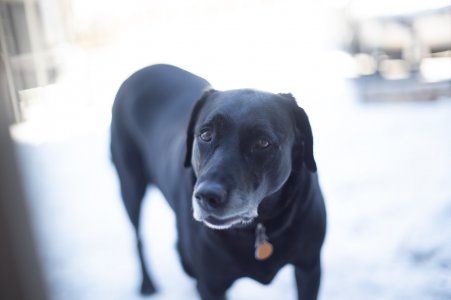
Funny, I bought this because I couldn't afford the rangefinder version of this thing . . . a massive 50mm f:1.2 lens. I couldn't afford one when they were new. Now that they are fairly rare birds, I really can't afford one. (Just saw one on eBay for almost $2,500 - yikes). But the 57 in AR mount remains reasonable available for the obsessed. I learned today that it was made with Thorium glass? Good to know.
The subject is Moxie, the wonder lab, who is asking in dog-speak whether it is now playtime, or whether I am going to continue sitting in the warm house like a rrrrrr-loser. The look you are seeing in her eyes? That's reproach.
As you can see there is a bit of low contrast at max aperture. In dark settings, where you'd be reasonably expected to use f:1.2, that's not necessarily a bad thing as those settings can be high contrast, even if they are generally low light. At least that's the rationalization I hit on. But it does look like the old girl is ducking her head into the zone of focus there, leaving the rest of her dear corpus out in the OOF areas.

Benjamin Marks
Mentor
I was going to do a little "Sonnar face-off" among some of the 50mm lenses that I have kicking around. One set of shots wide open with each of the group below. One set at f:5.6 of the same scene with the same lenses. I learned something about this kind of pixel peeping lens test though. A couple of things actually, both kind of dumb facts. The first is that if you have your camera set to have the ISO float, and you reduce your aperture. . . you get higher ISOs. Duh. Life was simpler when I only had ISO 400 to worry about. So I'm not posting those pix because comparing a modern C/V manufactured Zeiss Sonnar @ f:1.5 with an older Opton at f:5.6 doesn't tell you much when one ISO is 100 and the other is 22,800. Dumb. So if you are doing table-top photography, you really have to turn off your Auto ISO and just pick a number. Pick 64. Or Pick 500. Either would have allowed for a more apples-to-apples comparison.
The other things I "learned" -- which I already actually knew -- is that when you take a lens from the early 'oughts and compare it with a cloudier version of a similar optical formula from the 1950's, the modern coatings give a certain "snap" and the older haze gives a certain foggy imprecision. Not much learned there.
Just to keep this on topic, here are some of the lenses tested, but taken with a C/V 58/1.4 Nokton stopped down to f:11 (and at ISO 22,800). Those of you looking at the edge of the frame will see what happens when you try to photograph something on a table in the presence of a cat. That's Sasha. It is her table. She was just making sure I knew it.
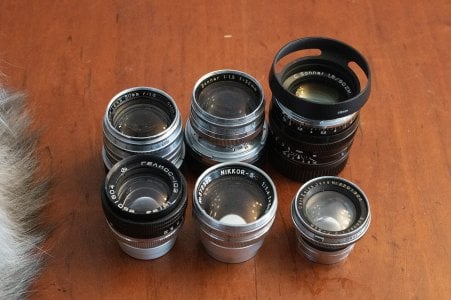
The other things I "learned" -- which I already actually knew -- is that when you take a lens from the early 'oughts and compare it with a cloudier version of a similar optical formula from the 1950's, the modern coatings give a certain "snap" and the older haze gives a certain foggy imprecision. Not much learned there.
Just to keep this on topic, here are some of the lenses tested, but taken with a C/V 58/1.4 Nokton stopped down to f:11 (and at ISO 22,800). Those of you looking at the edge of the frame will see what happens when you try to photograph something on a table in the presence of a cat. That's Sasha. It is her table. She was just making sure I knew it.

Benjamin Marks
Mentor
Here's an example of what the Sonnar will do wide open compared to the Helios 103. The Sonnar is first, the Heliar image is below it. I think the boost in contrast is partially the effect of modern multi-coatings on the Zeiss/Cosina lens. Of course the Helios is a Gauss design, not a Sonnar, but it's what I had lying around, so forgive the self-indulgence. One nice feature of the Z8? Once you are focusing through the lens, it really doesn't matter whether your adapter is a Nikon mount or a Contax mount. Just slap it on there and shoot away . . .
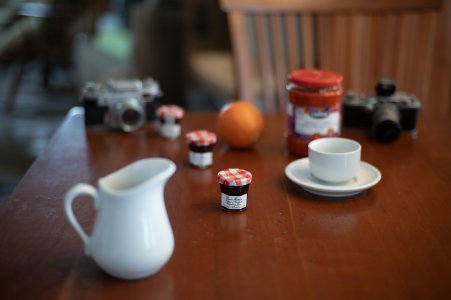
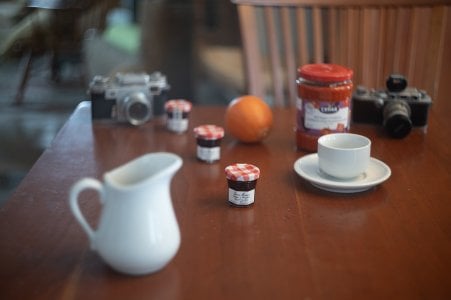


Last edited:
Benjamin Marks
Mentor
Cosina Voigtlander 15/4.5 @ f:11. The crazy thing about a lens this wide is that there is very little distortion -- much less than I'd expect anyway. You do have to poke at the corners to deal with light fall-off. Not sure I got it right in the following. But was fun trying. Reflection at the bottom of a wheelbarrow:
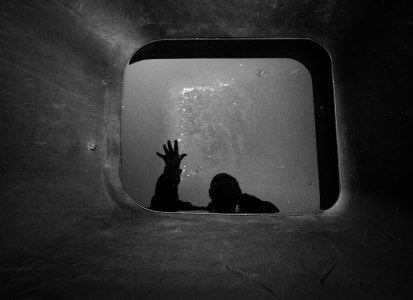
I did crop this a bit on the right side to get rid of a framing problem. That dang 15 just "sees" so much. It is not an everyday lens, but I find I use it a lot more than I thought I would when travelling. I now have three versions of this lens -- the original uncoupled LTM (hey, the Z8 doesn't care about RF coupling either), the M-mount version and now the Z-mount. The first two are tiny by comparison. Heck, the appeal of the original LTM mount lens was that it weighed next to nothing. You could put one in your bag when traveling and just forget about it until you were in front of a subject that could use the coverage.
Here's one where I goobered the adjustment. Looks a little too HDR for me. But you can see that the trees aren't distorted particularly. Astonishing,
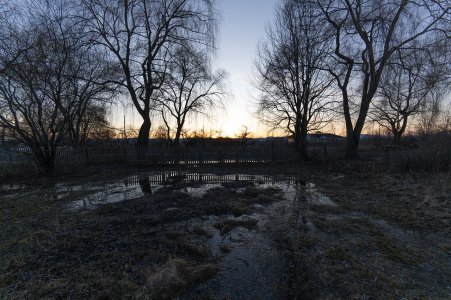

I did crop this a bit on the right side to get rid of a framing problem. That dang 15 just "sees" so much. It is not an everyday lens, but I find I use it a lot more than I thought I would when travelling. I now have three versions of this lens -- the original uncoupled LTM (hey, the Z8 doesn't care about RF coupling either), the M-mount version and now the Z-mount. The first two are tiny by comparison. Heck, the appeal of the original LTM mount lens was that it weighed next to nothing. You could put one in your bag when traveling and just forget about it until you were in front of a subject that could use the coverage.
Here's one where I goobered the adjustment. Looks a little too HDR for me. But you can see that the trees aren't distorted particularly. Astonishing,

Benjamin Marks
Mentor
In the "Golden Age of Lens Interchangeability" thread (The Golden Age of Lens Interchangeability is Now!) , I noted that there are now Leica-to-Nikon Z adapters with their own short-throw helicals. I suspect that the narrow difference between the Leica and Nikon-Z focusing registries limits what you can do with these, but I have one from Photodiox and it is a pretty nicely machined bit of kit. And it addresses one of my only frustrations with Leica lenses -- their minimum focusing distance of about three feet, which I always suspected was more about the limitations of the "Messsuchersystem" (which always sounded to me like a system for depositing sugar in pastries, rather than a rangefinder) than anything else. As observed in that other thread the M adapters with helicals let you ooch a little closer to your subject than the lens' minimum focussing distance. Not a lot -- this isn't a full blown extension tube. But it would let you get closer to filling the camera's frame with your subject, depending on the size of things. I like portraiture, so the size of a human head is about what I want to fill the frame.
So here's an image from this morning with the Leica 90 Apo Asph at its minimum focus distance:
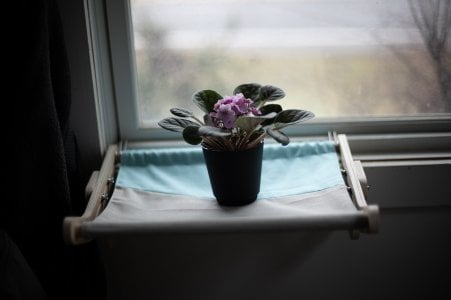
Nice contrast, sharp detail at the center of the African Violet etc. Here's what you get when you rack the helical adapter all the way out with the same lens and aperture (f:2 btw):
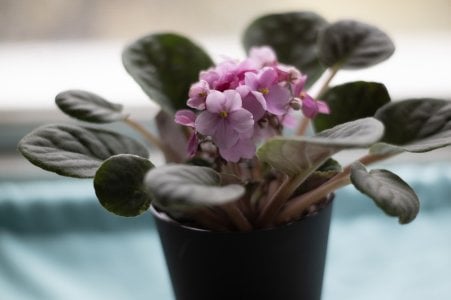
So, not exactly macro photography, but a distinct advantage given the 90 AA's inherent limitations. Could you do this with an extension tube? Of course. But using this adapter you just rack the helical back in and you are back to the 90 AA's normal focus characteristics. Downsides? Well, more mechanical linkages means more stuff to go wrong. And if the machining is off on the adapter, then when you rack the lens away from the sensor plane, you are just going to exaggerate those tolerance problems. But in my case, I haven't noticed anything jarring. So: net net it it's an extra tool in the tool kit.
So here's an image from this morning with the Leica 90 Apo Asph at its minimum focus distance:

Nice contrast, sharp detail at the center of the African Violet etc. Here's what you get when you rack the helical adapter all the way out with the same lens and aperture (f:2 btw):

So, not exactly macro photography, but a distinct advantage given the 90 AA's inherent limitations. Could you do this with an extension tube? Of course. But using this adapter you just rack the helical back in and you are back to the 90 AA's normal focus characteristics. Downsides? Well, more mechanical linkages means more stuff to go wrong. And if the machining is off on the adapter, then when you rack the lens away from the sensor plane, you are just going to exaggerate those tolerance problems. But in my case, I haven't noticed anything jarring. So: net net it it's an extra tool in the tool kit.
Benjamin Marks
Mentor
Here's the same concept with a C/V Nockton 1.1 wide open and the extension racked out. Note that when you use this technique, you do take a slight hit on exposure and depth of focus (just the way you would with an extension tube). But in these cases, the camera is better/faster/stronger than my non-bionic brain and I just let the camera do the compensation. Setting here: auto-everything, turn your brain off, point-and-shoot.
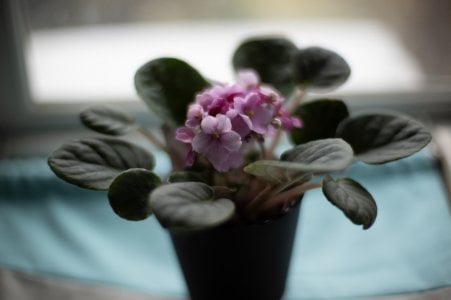
Like a lot of superspeed lenses, the Nokton gets all glow-y at its maximum aperture. I consider that a feature, not a bug, but folks will have their own sense of what can work for them. Funny, I bought the Nokton about 10 years ago so I wouldn't risk my precious Noctilux in certain situations. I fully admit that that's nuts. Why have a lux lens if you aren't going to use it? Turns the thing into a luxurious paperweight. Still, that's another subject.

Like a lot of superspeed lenses, the Nokton gets all glow-y at its maximum aperture. I consider that a feature, not a bug, but folks will have their own sense of what can work for them. Funny, I bought the Nokton about 10 years ago so I wouldn't risk my precious Noctilux in certain situations. I fully admit that that's nuts. Why have a lux lens if you aren't going to use it? Turns the thing into a luxurious paperweight. Still, that's another subject.
Out to Lunch
Menteur
The 4.5/15 Heliar III, which is optimized for digital use, produces much better results. Cheers, OtLfrom the Voitlander 15/4.5 Heliar II M-mount.
Benjamin Marks
Mentor
Yup. Read that on the interwebs. So I bought one. Those pictures in post #29 (wheelbarrow reflection) were with the new version of the lens. I can confirm that the lens feels like it was made for the Z8 and produces very nice results on the camera. And if there is no autofocus, who cares? I am unlikely to need focus-tracking-missle-lock with a 15mm lens . . . stunning piece of glass.The 4.5/15 Heliar III, which is optimized for digital use, produces much better results. Cheers, OtL
Thing is, I can't even label Out To Lunch an "enabler" on this one, as I enabled myself right into a copy of the lens earlier this week.
I guess all of you who have cameras with nice high ISO capabilities have figured this out already, but other than the optical qualities of shallow depth of field, an f:2.8 (or an f:/4.5) lens doesn't have to scare you off from available-light work. In the whirlwind rotation of non-Leica glass on the relatively new Z8, it is currently wearing the little (C/V) Zeiss 35/2.8 Biogon. Absolutely fabulous little lens -- if not the speediest. But with IBIS and high-ISO capabilities? I hardly notice the speed issue.
Benjamin Marks
Mentor
Today's 10 minute break experiment. Comparison of a brand new Voightlander Nokton 55/1.2 in F mount with a Cosina made 50 Planar/1.4 in ZF mount. I find the renderings of these two lenses fairly similar and a look at the block diagrams for each lens suggests why. Here are two comparison pix, the first with the Nokton, the second with the Planar, both hand-held wide open with the Z8's IBIS "on."
Nockton:
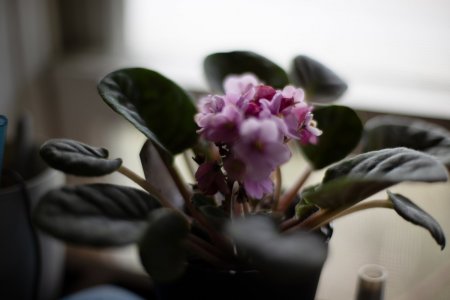
Planar:
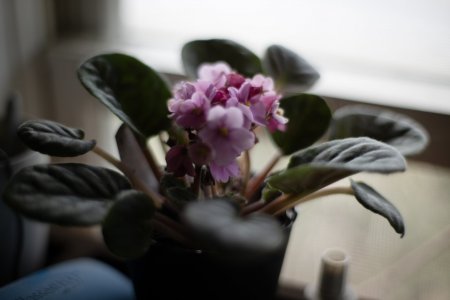
Block diagram for the Nockton:
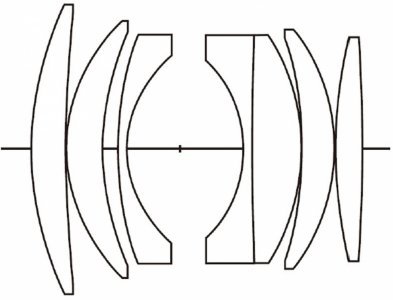
And that of the Planar:
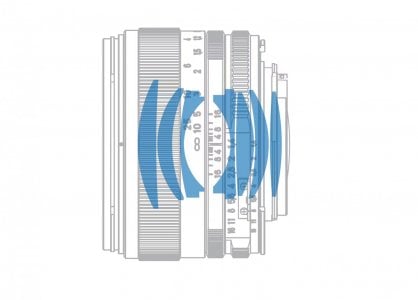
I wouldn't go so far as to say they are essentially the same lens, but I would say that the similarities outweigh the differences in this kind of quick-and-dirty comparison.
Nockton:

Planar:

Block diagram for the Nockton:

And that of the Planar:

I wouldn't go so far as to say they are essentially the same lens, but I would say that the similarities outweigh the differences in this kind of quick-and-dirty comparison.
Last edited:
Benjamin Marks
Mentor
The peril of the 28's.
So I was pretty blithe at the top of this post about the Z8's ability to handle third-party wide angle lenses. I want to preface this by saying that this might be a problem that is bigger when you test for it than it is in the real world. So, more boring pictures of my almost 18% grey deck and a few observations follow. 28's are one my go-to lenses -- wide but not too wide, if you know what I mean. "One step backwards with your 35mm lens" might sum it up. As I mentioned, I am taking photos of a friend's wedding this summer. Been thinking about the Nikon 26 or 28 (which I don't own . . . yet) -- particularly as some of the images will be the bride with her friends "getting ready" - and ditto the groom. So these are indoor, available light, candid pictures. f:2.8 and be there?
I mentioned that I have a couple of lenses already to hand. . . actually, I will probably get around to testing them all, but my sense is already that I am in a "you get what you pay for" moment. So that 28/3.5 Sears brand Pentax M42 thread mount lens? Probably not seeing the light of day on this one. But I do have some favorites, so I decided to start with those.
I have a 28 Contax G mount Biogon converted to M mount by some wizards in Japan. Nifty, tiny, beautiful little thing. How would it do in a M-to-Z mount adapter? Well here is the promised boring shot at f:2.8 where you'd expect the vignetting to be worst:
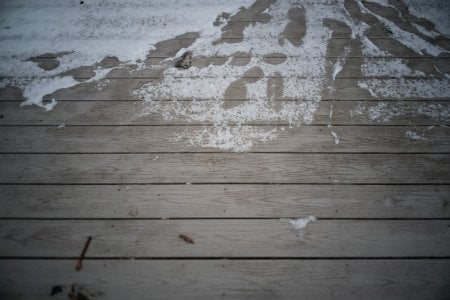
Jeezum-Crow as they say in my part of the world. That vignetting is pretty ugly. This is more or less what the camera produced, with all of the usual caveats about de-rez'ing and downsizing the file for posting. But still.
Camera RAW does try and help. Here's the same file with the 2.8 Zeiss Biogon corrections applied in Camera RAW and the vignette slider pegged all the way to the left:
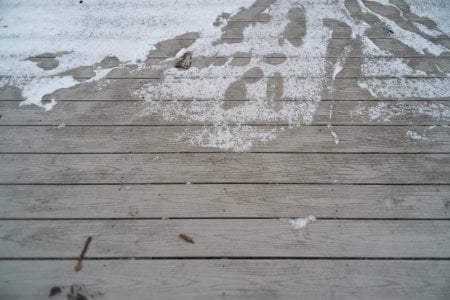
Not the worst, but wedding-worthy? Not with those greenish corners. I won't post pix of the ZM Biogon -- basically the exposure pattern is identical to the G-Biogon.
On the other hand, here is the 28 Elmarit-R uncorrected:
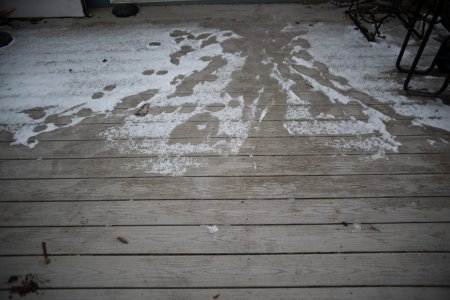
About the same as the M-mount lens on casual inspection, right? But here is the Elmarit-R at 2.8 corrected as if it were a Zeiss ZM mount lens (don't ask me why but there are no vignetting sliders in the PS CameraRaw conversion profile for Leica? Zeiss? Yes. Leica? No. Bizzare.)
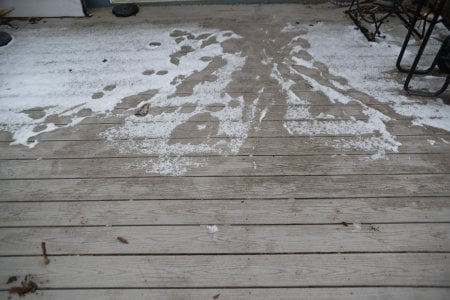
Actually, not that bad. I guess the R-to-Z adapter is further away from the sensor plane and the light rays at the corners of the images are are not going at such an extreme angle? Dunno. At any rate, I might be able to work with that slighter, correctable fall-off. I have read on-line that the Z28/2.8 has some pretty bad fall off when used wide open, so perhaps I'll dance with the one I already bought. I do need to try some Nikon AiS lenses of similar speed, and a Pentax or two. I'll post the results if you think you all can stand them.
I will also give the 28 Summicron-M a go on this torture test.
Also considering Contax SLR lenses for this application.
So I was pretty blithe at the top of this post about the Z8's ability to handle third-party wide angle lenses. I want to preface this by saying that this might be a problem that is bigger when you test for it than it is in the real world. So, more boring pictures of my almost 18% grey deck and a few observations follow. 28's are one my go-to lenses -- wide but not too wide, if you know what I mean. "One step backwards with your 35mm lens" might sum it up. As I mentioned, I am taking photos of a friend's wedding this summer. Been thinking about the Nikon 26 or 28 (which I don't own . . . yet) -- particularly as some of the images will be the bride with her friends "getting ready" - and ditto the groom. So these are indoor, available light, candid pictures. f:2.8 and be there?
I mentioned that I have a couple of lenses already to hand. . . actually, I will probably get around to testing them all, but my sense is already that I am in a "you get what you pay for" moment. So that 28/3.5 Sears brand Pentax M42 thread mount lens? Probably not seeing the light of day on this one. But I do have some favorites, so I decided to start with those.
I have a 28 Contax G mount Biogon converted to M mount by some wizards in Japan. Nifty, tiny, beautiful little thing. How would it do in a M-to-Z mount adapter? Well here is the promised boring shot at f:2.8 where you'd expect the vignetting to be worst:

Jeezum-Crow as they say in my part of the world. That vignetting is pretty ugly. This is more or less what the camera produced, with all of the usual caveats about de-rez'ing and downsizing the file for posting. But still.
Camera RAW does try and help. Here's the same file with the 2.8 Zeiss Biogon corrections applied in Camera RAW and the vignette slider pegged all the way to the left:

Not the worst, but wedding-worthy? Not with those greenish corners. I won't post pix of the ZM Biogon -- basically the exposure pattern is identical to the G-Biogon.
On the other hand, here is the 28 Elmarit-R uncorrected:

About the same as the M-mount lens on casual inspection, right? But here is the Elmarit-R at 2.8 corrected as if it were a Zeiss ZM mount lens (don't ask me why but there are no vignetting sliders in the PS CameraRaw conversion profile for Leica? Zeiss? Yes. Leica? No. Bizzare.)

Actually, not that bad. I guess the R-to-Z adapter is further away from the sensor plane and the light rays at the corners of the images are are not going at such an extreme angle? Dunno. At any rate, I might be able to work with that slighter, correctable fall-off. I have read on-line that the Z28/2.8 has some pretty bad fall off when used wide open, so perhaps I'll dance with the one I already bought. I do need to try some Nikon AiS lenses of similar speed, and a Pentax or two. I'll post the results if you think you all can stand them.
I will also give the 28 Summicron-M a go on this torture test.
Also considering Contax SLR lenses for this application.
Last edited:
Benjamin Marks
Mentor
Continuing with an exploration of 28's on the Z8 for the moment. Here are pictures from a 28/2 Nikkor-AIS, mostly at f:2.8. Vignetting is pretty well controlled. Color is great.
Here's a corrected f:2.8 compared with 5.6 on a flat subject close to the near focus limit:
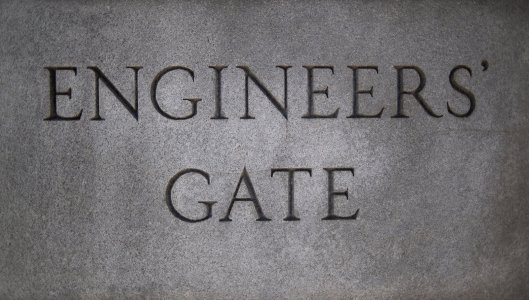
Little darkening of the corners, even with CameraRAW's vignetting correction dialed in. Here's 5.6:
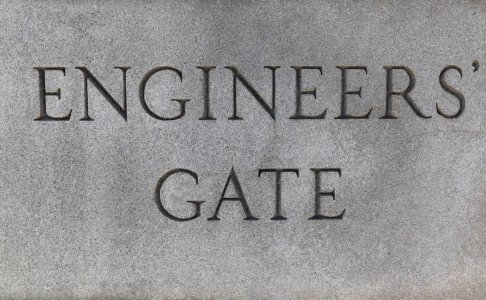
More even across the frame, although performance at f:2.8 would do, I think.
Here's a subject with more depth:
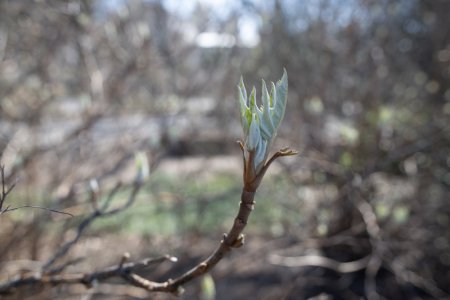
OOF areas are a little busy. Here's another:
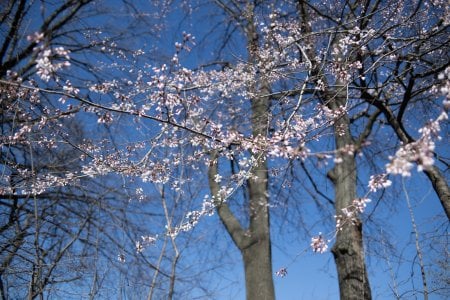
All in all I am liking the SLR 28's better than the RF 28's for these applications. Might have to get the 28 M-Summicron back out for a head to head at some point.
Here's a corrected f:2.8 compared with 5.6 on a flat subject close to the near focus limit:

Little darkening of the corners, even with CameraRAW's vignetting correction dialed in. Here's 5.6:

More even across the frame, although performance at f:2.8 would do, I think.
Here's a subject with more depth:

OOF areas are a little busy. Here's another:

All in all I am liking the SLR 28's better than the RF 28's for these applications. Might have to get the 28 M-Summicron back out for a head to head at some point.
Benjamin Marks
Mentor
Benjamin Marks
Mentor
It is challenging to show just how much detail I can see in my files while processing. The camera chose ISO 2000 here, in response to my dialing in f:4 on the lens. I have kept the original 300 dpi that is generated by CameraRAW here, down-sampled to 8x10 and applied more aggressive than usual JPG compression to the file below. As above, Contax 50/1.7 MM lens with a "dumb" adapter on the Z8:
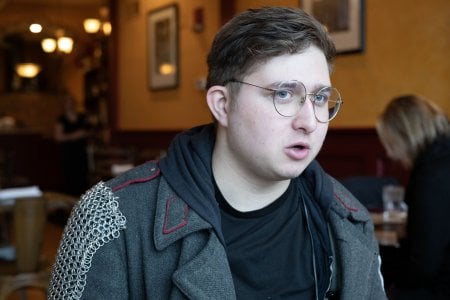

Last edited:
Benjamin Marks
Mentor
Benjamin Marks
Mentor
Share:
-
This site uses cookies to help personalise content, tailor your experience and to keep you logged in if you register.
By continuing to use this site, you are consenting to our use of cookies.


